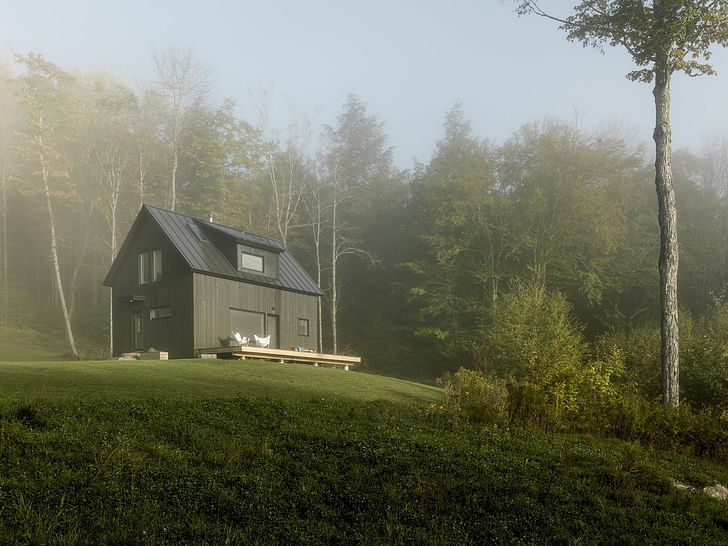

For this latest installment of Studio Snapshot, Archinect reached out to Elizabeth Herrmann, Founder and President of Vermont-based residential architecture firm Elizabeth Herrmann Architecture + Design.
The conversation touched on her motivations to start her own practice, the challenges of running a small design firm during a pandemic, and her aspirations for future development.
Can you tell us how Elizabeth Herrmann Architecture + Design was founded?
I founded my firm in 2007 with the goal of trying to bring some fresh and more modern design thinking to residential Vermont architecture. Vermont architecture, and especially residential architecture, seemed a bit stagnant to me, and I wanted to see if there might be other opportunities for more interesting work if I struck out on my own and forged new relationships. Also, as a mother of young children at the time, and as someone with a strong creative drive, I craved the flexibility and autonomy of my own practice so I could better balance family and work and more easily chart my own life course.
How many people are currently employed at the firm? How is your office structured?
Right now, I have three employees. We work in a collaborative, egalitarian, informal, open studio (surrounded by material samples!). I really try to provide a work environment that promotes growth and development.
I founded my firm in 2007 with the goal of trying to bring some fresh and more modern design thinking to residential Vermont architecture.
Would you like to scale up and grow your team? What do you consider the ideal size for your practice?
I think we are at our ideal size. I like to stay small, agile, and maintain a boutique feel. I want our clients to know that their projects get our full attention.
What have been the biggest challenges starting and running your own practice?
There is never enough time in a day. I have so many things I’d like to do and achieve, and it is hard to fit it all in.
What challenges have you faced during the past pandemic months? Has remote work been a solution?
Because my studio is at home (in an outbuilding), my daily life hasn’t changed all that much. For a while, my coworker worked at home, but we’re now back in the office together. We social-distance and screen-share via Zoom when we need to discuss a drawing or detail. Client interface has changed in that face-to-face meetings are less frequent. Many of our clients are elsewhere, though, so we did lots of virtual meetings way before the pandemic. Our work process and design platforms are very digitally-friendly and have been for a long time.
Describe your work. How do you define your own unique style and approach?
I don’t see a divide between architecture and interiors. I believe the best buildings are conceived as a cohesive whole. We design everything in our projects, from building envelopes and wall details to millwork, lighting, finishes, and fixtures. All of our design work is attuned to our clients' likes, lifestyles, aspirations, and budgets. We don’t have a one-size-fits-all approach to anything we do since each client and site is different and because advances in building tech are constantly allowing us to improve our work and evolve.
We design everything in our projects, from building envelopes and wall details to millwork, lighting, finishes, and fixtures.
What do you want your firm to be known for?
I’m not quite ready to think about a legacy. Right now, we're focused on doing our very best work, advancing performance and design. We're every bit as excited to work on a micro house for a tiny budget as we are working on a larger, more expensive home. The diversity and variety keep us engaged and excited. We also value the relationships we have with builders and tradespeople. We enjoy the collaboration and teamwork and know that those partnerships are essential to doing good work.
Where do you see your company in 5 years?
I hope in five years to have some hand in creating more innovative approaches to design, performance, and delivery of projects. I see such potential for prefabrication for some projects, as well as automation. I’m currently partnering with a prefab company to develop some small houses for production, for example.
I’m currently partnering with a prefab company to develop some small houses for production.
Do you have a favorite project? Completed or in progress.
I do have some favorites — my most recent work including the Elemental House, Little Black House, and the Micro House are all near and dear to me. In all three, the clients’ visions were not prescriptive and were aspirational. I had the space to be creative and in doing so was able to find more innovative ways of achieving project goals.
If you could describe your work/practice in three words, what would they be?
Creative: I try to uphold high design standards and to encourage interrogation of our work and challenge us to do better all the time.
Joyful: I truly love my job.
Inclusive: I try to work with clients at all budget levels and strive to mentor and support emerging architectural talent whenever possible, recognizing a need in particular to give women in the profession opportunities to succeed and overcome barriers to both experience and advancement.
Alexander Walter grew up in East Germany with plenty of Bratwurst. He studied Architecture and Media Design at Bauhaus-Universität Weimar, Germany, and participated in foreign exchange programs with Washington-Alexandria Architecture Consortium in Alexandria, Virginia and Waseda University in ...
1 Comment
Refreshing to see uncomplicated architecture.
Block this user
Are you sure you want to block this user and hide all related comments throughout the site?
Archinect
This is your first comment on Archinect. Your comment will be visible once approved.